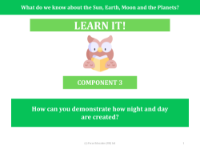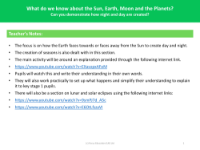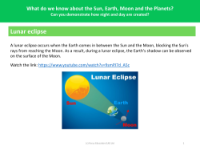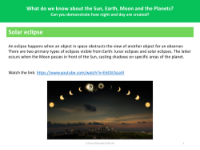Why do we have night and day? - Investigation instructions

Science Resource Description
The intriguing phenomenon of night and day is a fundamental concept that can be explored through an engaging investigation. To delve into the reasons behind the daily transition from daylight to darkness, students are encouraged to watch an educational video clip that explains this natural occurrence. During the viewing, note-taking is an essential part of the process, allowing students to capture key points and later discuss them with a partner to consolidate their understanding. Repeated viewings of the clip are suggested to ensure a thorough comprehension of the content, and the use of diagrams is recommended to visually represent the interplay between the Earth, Sun, and Moon, which is central to the explanation of day and night, as well as the changing seasons.
In order to translate this knowledge into a teaching opportunity, students are tasked with creating a practical demonstration aimed at explaining the concept of night and day to younger learners, specifically those in year 2. The demonstration should be clear and simple enough for the young audience to grasp. Using a torch to represent the Sun, a dark room to simulate the space environment, and different sized balls to stand in for the Earth and possibly other celestial bodies, students will illustrate how the Earth's rotation results in the cycle of day and night. This hands-on activity not only reinforces the students' own understanding but also helps them learn how to communicate complex ideas in an accessible manner. The ultimate goal is to demonstrate the rotational dynamics between the Sun, Earth, and Moon, making the concept of night and day come alive for young inquisitive minds.






